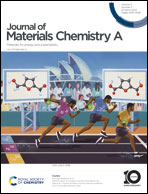A binder-driven cathode–electrolyte interphase via a displacement reaction for high voltage Na3V2(PO4)2F3 cathodes in sodium-ion batteries†
Abstract
Sodium super ionic conductor (NASICON)-structured Na3V2(PO4)2F3 (NVPF) is a promising cathode for application in sodium-ion batteries (SIBs) because of its high working potential (3.7 V and 4.2 V vs. Na/Na+) and structural stability. Nonetheless, interfacial instability deteriorates its electrochemical performance. Therefore, to overcome this limitation, we introduced a sodium polyacrylate (NaPAA) binder for NVPF cathodes. The NaPAA binder effectively suppresses electrolyte decomposition by uniformly covering NVPF particles. Furthermore, the sodium carboxylate group of R–COONa in the NaPAA binder can react with the HPO2F2 intermediate generated by the hydrolysis of NaPF6 and be converted into R–COOH and NaPO2F2via the displacement of Na+ by H+. This results in the formation of a stable and Na-ion conductive NaPO2F2-rich cathode–electrolyte interphase (CEI) layer. In addition, the NaPAA-based electrode exhibits desirable cycling and rate performances compared to those of conventional poly(vinylidene difluoride)-based electrodes. This study provides new insights into the design of CEI layers by introducing chemical functional groups in the binder for high-performance SIB cathodes.



 Please wait while we load your content...
Please wait while we load your content...